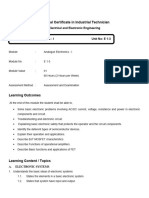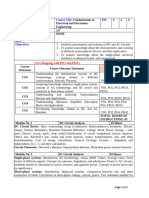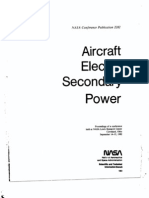0 ratings0% found this document useful (0 votes)
20 views2018 ECE Annex V - Sample Course Specification For Electronic Devices and Circuit Lecture
The course syllabus describes an Electronics Engineering course on Electronic Devices and Circuits. The 3 unit course introduces concepts of quantum mechanics, semiconductor characteristics, diode and transistor models and applications. Key topics include diode and transistor biasing, small and large signal analysis, and Boolean logic. The course outcomes involve explaining semiconductor and device concepts, analyzing circuits using diodes and transistors, and discussing applications of diodes, BJT and FET transistors. The course outline covers semiconductor theory, diode circuits, transistor biasing and analysis for BJT and FET devices.
Uploaded by
Janice PusposCopyright
© © All Rights Reserved
Available Formats
Download as PDF, TXT or read online on Scribd
0 ratings0% found this document useful (0 votes)
20 views2018 ECE Annex V - Sample Course Specification For Electronic Devices and Circuit Lecture
The course syllabus describes an Electronics Engineering course on Electronic Devices and Circuits. The 3 unit course introduces concepts of quantum mechanics, semiconductor characteristics, diode and transistor models and applications. Key topics include diode and transistor biasing, small and large signal analysis, and Boolean logic. The course outcomes involve explaining semiconductor and device concepts, analyzing circuits using diodes and transistors, and discussing applications of diodes, BJT and FET transistors. The course outline covers semiconductor theory, diode circuits, transistor biasing and analysis for BJT and FET devices.
Uploaded by
Janice PusposCopyright
© © All Rights Reserved
Available Formats
Download as PDF, TXT or read online on Scribd
You are on page 1/ 3
Annex V – SAMPLE COURSE SYLLABUS
BS ELECTRONICS ENGINEERING
Course Name: ELECTRONIC DEVICES AND CIRCUITS (LECTURE)
Introduction to quantum mechanics of solid state electronics; diode
and transistor characteristics and models (BJT and FET); diode
Course circuit analysis and applications; transistor biasing; small signal
Description analysis; large signal analysis; transistor amplifiers; Boolean logic;
transistor switch.
Number of Units 3 units
Number of Contact
Hours per week 3 hours
Prerequisite Physics 2; Integral Calculus
Upon completion of the course, the student must be able to:
1. Explain the basic concept of atomic theory and relate it to the
characteristics of materials (POa, POe, POi)
2. Discuss the construction, basic operation, characteristics and
configurations of semiconductor diodes (POa, POb, POe, POi)
3. Analyze the function of semiconductor diode in some practical
applications (POa, POb, POe, POi)
Course Outcomes 4. Discuss the basic structure, operation and characteristics of Bipolar
Junction Transistors (BJT) (POa, POb, POe, POi)
5. Discuss the different configurations, DC Biasing and some practical
applications of BJT (POa, POb, POe, POi)
6. Discuss the basic structure, operation and characteristics of Field
Effect Transistors (FET) (POa, POb, POe, POi)
7. Discuss the different configurations, DC Biasing and some practical
applications of FET (POa, POb, POe, POi)
1. Introduction of Semiconductors
Discuss the concept of atomic theory, and the subatomic particles of the
atom. (CO1)
Identify and differentiate conductors, semiconductors and insulators. (CO1)
Discuss the crystal structure of the common semiconductor materials and
ions formed from covalent bonding. (CO1)
Explain the general characteristics of three important semiconductor
materials: Ge, Si and GaAs. (CO2)
Explain the concept of conduction in semiconductors using electron and
hole theory. (CO2)
Differentiate the difference between n – type and p – type materials. (CO2)
2. Diode Equivalent Circuits
Explain what happens in a diode during no bias, forward bias, and reverse
bias conditions. (CO2)
Identify the three equivalent model of the diode and plot its corresponding
characteristic curves. (CO2)
Calculate current and voltage for circuits with diode connected in series,
parallel or series–parallel using the different equivalent diode models.
(CO2)
Explain the diagram of a basic power supply and determine the waveform
produced by each block. (CO3)
3. Wave Shaping Circuits
Course Explain the process of rectification using diodes to establish a pulsating dc
Outline from a sinusoid ac input. (CO3)
Calculate and determine the output waveform of half-wave and full-wave
rectified signal. (CO3)
Calculate and determine the resulting output waveform of a bridge type,
transformer-coupled and center-tapped transformer rectifier. (CO3)
Design a clipper circuit given an output and an input. (CO3)
Analyze the output response of a clipper circuit. (CO3)
Design a clamper circuit given an output and an input. (CO3)
Analyze the output response of a clamper circuit. (CO3)
4. Special Diode Application
Interpret the characteristic curves of a zener diode. (CO2)
Draw the equivalent circuit of a zener diode. (CO2)
Explain how a zener diode produces a constant level of dc voltage during
reverse bias condition. (CO2)
Solve circuits with zener diodes. (CO2)
Discuss the basic characteristics and operation of LED’s, photodiodes,
Schottky, varactor, pin, step recovery, tunnel, and laser diodes. (CO2)
5. Power Supply And Voltage Regulation
Discuss how a voltage input is amplified with the use of capacitors and
diodes. (CO3)
Compute the ripple voltage produced by filtering a rectified output with the
use of a capacitor. (CO3)
Discuss how a ripple is produced. (CO3)
6. Bipolar Junction Transistor
Describe the basic structure of the BJT.
Explain how a BJT is biased and discuss the transistor currents and their
relationships. (CO4)
Discuss transistor parameters and characteristics and use this to analyze a
transistor circuit. (CO4)
Identify and differentiate the schematic symbol and construction of an npn
and pnp transistor. (CO4)
Discuss how a transistor amplifies an input voltage/ current. (CO5)
Discuss the operation of a transistor in cut-off and saturation region. (CO4)
Discuss the operation of a transistor in common configuration: common
base, common collector, and common emitter. (CO5)
Measure the important voltage levels of a BJT configuration and use them
to determine whether the network is operating properly. (CO4)
Analyze the saturation and cut-off conditions of a BJT network and the
expected voltage and current levels established by each condition. (CO4)
Apply proper biasing of a transistor to ensure proper operation in the active
region. (CO5)
Perform dc analysis of BJT using different biasing configurations. (CO5)
7. Small- Signal Analysis (BJT)
Use BJT in an application where its amplification and switching
capabilities are used. (CO5)
8. Field Effect Transistor
Describe the basic structure of the JFET. (CO6)
Explain how a JFET is biased and discuss the transistor currents and
their relationships. (CO6)
Discuss transistor parameters and characteristics and use this to analyze
a transistor circuit. (CO6)
Identify and differentiate the schematic symbol and construction of a p –
channel and an n- channel JFET. (CO6)
Sketch the transfer characteristics from drain characteristics of a JFET.
(CO6)
Discuss the characteristics and operation of a D-MOSFET. (CO6)
Discuss the characteristics and operation of an E-MOSFET. (CO6)
Discuss the differences between the dc analyses of the various types of
FET’s. (CO7)
Apply proper biasing of a FET to ensure proper operation in the desired
region. (CO7)
Perform dc analysis of JFET, MOSFET, and MESFET using different
biasing configurations. (CO7)
9. Small-Signal and Large Analysis (FET)
Solve combination of FET’s in a single network (CO7)
Use JFET in an application where its transfer characteristics are used.
(CO7)
You might also like
- School: SET Batch: 2018-2022 Program: B.Tech Current Academic Year: 2018-2019 Branch: Semester: INo ratings yetSchool: SET Batch: 2018-2022 Program: B.Tech Current Academic Year: 2018-2019 Branch: Semester: I3 pages
- BASIC ELECTRONICS (3110016) - AssignmentsNo ratings yetBASIC ELECTRONICS (3110016) - Assignments6 pages
- Syllabus EEE112 Electric and Electronics Engineering (Co6)No ratings yetSyllabus EEE112 Electric and Electronics Engineering (Co6)5 pages
- APznzaZaTxzb -Fgc4Ye3N6lTLL-Mh0khaMrCmgYZyDWE8Sq2oRTStwvpL09xkKuLUUz 25FmiIV QPvjFAf4piDogRohoftErZe MO7i ...CmXN3 YTG01-W7KQ2dyCVfhYpm4SObq6UE5L5cYuQxO2vq41JysrAFrlwpvpFFkqRN-Oq6WYzbwkd-W2iHniKkk9SFPsgUcMT0kY9R12GOFw2oTui703792qeJNo ratings yetAPznzaZaTxzb -Fgc4Ye3N6lTLL-Mh0khaMrCmgYZyDWE8Sq2oRTStwvpL09xkKuLUUz 25FmiIV QPvjFAf4piDogRohoftErZe MO7i ...CmXN3 YTG01-W7KQ2dyCVfhYpm4SObq6UE5L5cYuQxO2vq41JysrAFrlwpvpFFkqRN-Oq6WYzbwkd-W2iHniKkk9SFPsgUcMT0kY9R12GOFw2oTui703792qeJ5 pages
- 4.1 INTRODUCTION TO ELECTRONICS SyllabusNo ratings yet4.1 INTRODUCTION TO ELECTRONICS Syllabus22 pages
- Electronic Devices and Circuits Question Bank PDF100% (1)Electronic Devices and Circuits Question Bank PDF8 pages
- EDC question bank I-II 2022-23_1560011621No ratings yetEDC question bank I-II 2022-23_15600116214 pages
- Electronic Devices and Circuits Laboratory-Viva QNNo ratings yetElectronic Devices and Circuits Laboratory-Viva QN3 pages
- Electronic Device and Circuits - Lab Viva Questions50% (2)Electronic Device and Circuits - Lab Viva Questions2 pages
- Syllabus for Transistors and Their ApplicationsNo ratings yetSyllabus for Transistors and Their Applications3 pages
- Op-Amp Applications: Summing, Integrator, Differentiator, V-I and I-V ConvertersNo ratings yetOp-Amp Applications: Summing, Integrator, Differentiator, V-I and I-V Converters3 pages
- Course Outlines Basic Electronics Spring 2023No ratings yetCourse Outlines Basic Electronics Spring 20232 pages
- Ece1002 Fundamentals-Of-Electrical-And-Electronics-Engineering Ela 2.0 5 Ece1002 Feee 2.0No ratings yetEce1002 Fundamentals-Of-Electrical-And-Electronics-Engineering Ela 2.0 5 Ece1002 Feee 2.03 pages
- 312094599 Electronic Devices and Circuits Question Bank PDFNo ratings yet312094599 Electronic Devices and Circuits Question Bank PDF8 pages
- 23EEI101 - Basics of Electrical and Electronics EngineeringNo ratings yet23EEI101 - Basics of Electrical and Electronics Engineering2 pages
- Organic Light-Emitting Transistors: Towards the Next Generation Display TechnologyFrom EverandOrganic Light-Emitting Transistors: Towards the Next Generation Display TechnologyNo ratings yet
- Heterojunction Bipolar Transistors for Circuit Design: Microwave Modeling and Parameter ExtractionFrom EverandHeterojunction Bipolar Transistors for Circuit Design: Microwave Modeling and Parameter ExtractionNo ratings yet
- 2018 ECE Annex VI - USAID PBEd Workshop OutcomesNo ratings yet2018 ECE Annex VI - USAID PBEd Workshop Outcomes2 pages
- 2018 ECE Annex II - Sample ECE Curriculum Map 2018No ratings yet2018 ECE Annex II - Sample ECE Curriculum Map 20183 pages
- Power Supply - Current Limiters Using Transistors and Diodes - Electrical Engineering Stack ExchangeNo ratings yetPower Supply - Current Limiters Using Transistors and Diodes - Electrical Engineering Stack Exchange3 pages
- IRGP30B60KD-E: Insulated Gate Bipolar Transistor With Ultrafast Soft Recovery DiodeNo ratings yetIRGP30B60KD-E: Insulated Gate Bipolar Transistor With Ultrafast Soft Recovery Diode12 pages
- 1.three Phase Induction Motor Protection System89% (9)1.three Phase Induction Motor Protection System122 pages
- Chapter 1 - Introduction To Automotive Electrical and Electronic System100% (4)Chapter 1 - Introduction To Automotive Electrical and Electronic System26 pages
- Semiconductor _ Practice Sheet __ Vijeta 2025No ratings yetSemiconductor _ Practice Sheet __ Vijeta 20255 pages
- AOL1428 N-Channel Enhancement Mode Field Effect Transistor: Features General DescriptionNo ratings yetAOL1428 N-Channel Enhancement Mode Field Effect Transistor: Features General Description6 pages
- Load-Dump Protection For 24V Automotive Applications - Analog DevicesNo ratings yetLoad-Dump Protection For 24V Automotive Applications - Analog Devices22 pages






























































































